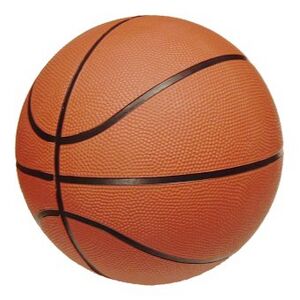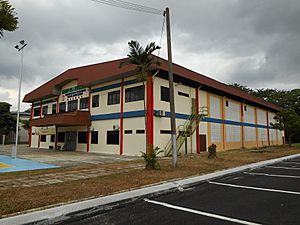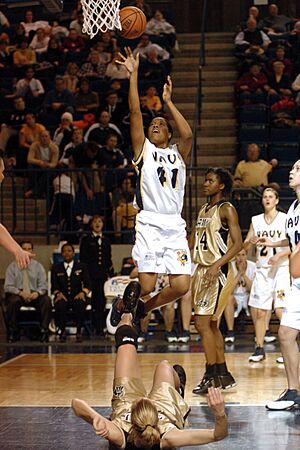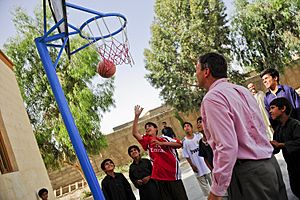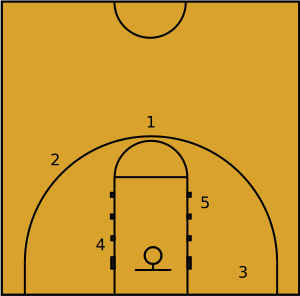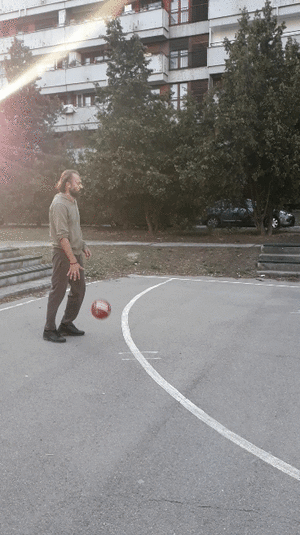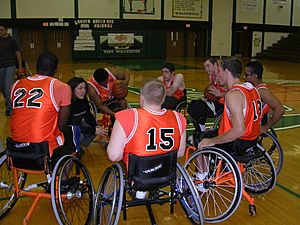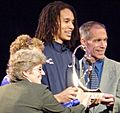Basketball facts for kids

|
|
| Highest governing body | FIBA |
|---|---|
| First played | December 21, 1891 Springfield, Massachusetts, U.S. |
| Characteristics | |
| Contact | Limited-contact |
| Team members | 5 per side |
| Mixed-sex | Yes, separate competitions |
| Type | Indoor/Outdoor |
| Equipment | Basketball |
| Venue | Indoor court (mainly) or outdoor court (Streetball) |
| Presence | |
| Country or region | Worldwide |
| Olympic | Yes, demonstrated in the 1904 and 1924 Summer Olympics Part of the Summer Olympic program since 1936 |
| Paralympic | Yes |
Basketball is a popular team sport played by two teams on a rectangular court. Each team usually has five players on the court at one time.
The main goal of the game is to shoot a ball through a hoop on the opponent's side of the court. At the same time, your team tries to stop the other team from scoring in your hoop. Most shots are worth two points, but shots from behind a special line are worth three points.
Basketball was invented in 1891 by James Naismith. The first public game was played in 1892. Today, it is played all over the world with a round, bouncy ball. Players use skills like dribbling (bouncing the ball), shooting, running, and jumping.
A game of basketball has four parts, called quarters. The team with the most points when the game ends wins. If the score is tied, teams play extra time, called "overtime," until one team wins. Basketball is played by both men's and women's teams. It has been part of the Summer Olympic Games since 1936.
Contents
The History of Basketball

Basketball was created in December 1891 by James Naismith. He was a physical education teacher in Springfield, Massachusetts, USA. Naismith wanted to invent a fun indoor game to keep his students active during the cold winter months.
The very first basketball game was played at the International Young Men's Christian Association (YMCA) in Springfield. Today, there's a sculpture outside where that first game happened. The Naismith Memorial Basketball Hall of Fame is also located in Springfield.
For that first game, Naismith used two peach baskets nailed to poles that were 20 feet high. This is how the sport got its name! He taught his students the rules he had written, and the game began. William R. Chase made the only score in that first game with a shot from the middle of the court.
News about the new game spread quickly. Many groups asked Naismith for copies of his rules. These rules were published in a school paper on January 15, 1892. Back then, there were no limits on how many players could be on a team. Naismith watched how the game was played and changed the rules as needed.
Equipment Needed for Basketball
The game of basketball is played on a rectangular court. At each end of the court, there is a goal called a "hoop." It looks like a circular basket with the bottom cut out.
To play a game of basketball, you need a few main things:
- A basketball
- A basketball court
- A basketball hoop and a backboard (the board behind the hoop)
Basketball Teams
In basketball, two teams play against each other. Each team has five players on the court at one time. Other players sit on the sideline, ready to join the game. These players are called "substitutes" or "bench players."
The number of players allowed on the bench can be different depending on the league. For example, in international games, teams can have up to 7 players on the bench. This means a team has a total of 12 players. In the NBA, teams have 13 players. College and high school teams can have 15 players.
When a player needs to enter the game, they tell the scorekeepers. The referee then signals for the new player to come onto the court. The player who was in the game leaves, and the new player takes their place. This is called a "substitution." In some local games, a team might need at least 3 players on the bench.
How Basketball is Played
A basketball game is usually divided into four quarters. Each quarter is 10 minutes long, but in the NBA, they are 12 minutes long. College games have two 20-minute halves instead.
To start the game, the referee throws the ball up in the air in the center of the court. One player from each team jumps to try and hit the ball to their teammates. This is called a "jump ball."
Teams move the ball forward by shooting, passing (throwing the ball to a teammate), or dribbling it (bouncing it while moving). Players cannot walk or run more than two steps without dribbling the ball. If they do, it's called a "travel," and the other team gets the ball.
Points are scored by shooting the ball into the hoop. A normal shot is worth two points. If a player shoots from behind the large arched line on the court, called the "three-point line," the shot is worth three points.
If a player does something against the rules, it's called a "foul." If a player fouls someone who is shooting, the fouled player gets to shoot "free throws." These shots are taken from a straight line in front of the hoop, called the "foul line." No one can try to block a free throw. Each successful free throw is worth one point.
- If a player was trying a 2-point shot and got fouled, they get two free throws.
- If a player was trying a 3-point shot and got fouled, they get three free throws.
If a player fouls an opponent who is not shooting, the other team gets the ball. They throw it in from the side of the court. Players with the ball can dribble, pass, or shoot. They try to keep the ball from the other team.
You cannot kick the ball or hit it with your fist. If this happens, the other team gets the ball.
If a player commits five fouls, they cannot play in the rest of the game. Another player from the bench must take their place. If a team commits four fouls, the other team gets to shoot a free throw on any next foul that doesn't involve shooting.
After four quarters, the team with the most points wins. If the score is tied, they play a five-minute "overtime" period. They keep playing overtime periods until one team scores more points and wins.
Basketball Terms You Should Know
Here are some important terms used in basketball:
- Field goal is any shot made during normal play. It's worth 2 points, or 3 points if shot from outside the three-point line.
- Assist is when you pass the ball to a teammate, and they immediately score a basket.
- Rebound is catching the ball after someone has shot and missed the basket.
- Personal foul is when a player makes illegal contact with an opponent.
- Technical foul is a penalty for breaking certain rules, like arguing with officials or entering the court at the wrong time.
- Free throw is a shot taken from the free-throw line after a foul. Each free throw made is worth one point.
- If you miss a shot and get fouled, you get 2 free throws (for a 2-point shot) or 3 free throws (for a 3-point shot).
- If you make a shot and get fouled, you get 1 free throw.
- Steal is taking the ball away from an opponent without fouling them.
- Turnover is when the team with the ball loses it to the other team.
- Substitution (Sub) is when one player replaces another on the court.
- Double dribble is when a player dribbles the ball, stops, and then dribbles again. It's also when you dribble with two hands. This is against the rules, and the other team gets the ball.
- Carry is when a player holds the ball too much while dribbling, instead of just bouncing it.
- Travel is when a player moves both feet without dribbling the ball while holding it. The other team gets the ball.
- Shot clock is a timer that limits how long a team has to shoot the ball. It's usually between 24 and 35 seconds. If time runs out before a shot hits the rim or goes in, the other team gets the ball.
- Jump ball happens at the start of the game. The referee throws the ball up, and players jump to hit it to their teammates. It can also happen if two players hold the ball at the same time.
- Alternating possession is a way to restart the game instead of a jump ball. The ball is given to the team whose turn it is, based on an arrow.
- Clutch refers to a very important shot made at a difficult moment, often at the end of a close game.
- Backcourt violation is when a player crosses the half-court line with the ball and then goes back over the line.
- 3-second violation is when an offensive player stays in the painted area (the "lane") near the basket for more than 3 seconds. The other team gets the ball.
- 8- or 10-second violation is when a team fails to move the ball past the half-court line within the allowed time (8 seconds in some leagues, 10 in others). The other team gets the ball.
Basketball Officials
In a basketball game, there are officials who are not part of either team. Their job is to make sure the game is fair and runs smoothly. Here are some of these officials:
- Umpire: There can be one to five umpires in a game. They make sure players follow the rules. In the NBA, these officials are called "referees."
- Referee: In many leagues, there is one main referee. This person is in charge and makes the final decisions for most problems. They also throw the ball up for the jump ball at the start of the game.
- Timekeeper: This person keeps track of the game time and tells the referees when each quarter ends.
- Scorekeeper: This person records all the points scored, shots taken, fouls, and timeouts.
- Assistant Scorekeeper: This person helps the scorekeeper. They tell the scorekeeper who scored points and show how many fouls each player has.
- Shot Clock Operator: This person controls the shot clock. They need to be quick to reset the timer when needed.
Positions in Basketball
In basketball, each player usually has a specific job or role, called a position. When everyone does their job well, the team is more likely to win.
- Point guard (PG) (1) - This player leads the team's offense. They bring the ball across the court and help plan how the team will score. Point guards are often fast and good at handling the ball. They are like the "coach on the court."
- Shooting guard (SG) (2) - These players are usually a bit taller than point guards. Their main job is to make shots from longer distances, especially from the three-point line.
- Small forward (SF) (3) - Small forwards are often taller than guards. They are very flexible players who can do many things, like getting rebounds, passing to teammates, and scoring points.
- Power forward (PF) (4) - Power forwards are usually strong players who play closer to the basket, inside the three-point line. They focus on getting rebounds and scoring close-range shots.
- Center (C) (5) - Centers are usually the tallest players on the team. They score close to the basket, grab rebounds, and block shots on defense. They also start the game by jumping for the tipoff.
Some other positions, often used in professional basketball, include:
- Swingman - A player who can play both small forward and shooting guard.
- Stretch four - A player who can play both power forward and small forward.
- Point forward - A player who can play both point guard and a forward position.
- Forward-center - A player who can play both a forward position (usually power forward) and center.
Different Ways to Play Basketball
There are many different types of basketball games. Some are for people with disabilities, some are played with fewer players, and some use only half the court.
Wheelchair Basketball
In this version, all players are seated in wheelchairs. It's often played by people who cannot walk or play regular basketball. The rules are changed a little bit, but the main ideas of the game are the same.
3 on 3 Basketball
This is a very popular way to play a "pick-up game" of basketball. Pick-up games are informal games where teams are chosen right on the court, not from official leagues. Since there's no referee, the rules are usually more relaxed. Instead of 5 players, each team has only three players, which is why it's called "3 on 3."
While the exact rules can change depending on where you play, here are some common ones:
- The game is played on half of a court, not a full court.
- Players usually call their own fouls and rule breaks.
- Players start the ball from the top of the three-point line.
- After the other team gets the ball, they must take it out past the free-throw or three-point line before they can try to score.
- If there's a foul, the ball is just thrown in from the side; there are no free throws.
- Normal shots are worth one point, and shots from behind the three-point line are worth two points.
- The game is played until one team reaches a certain score, not for a set amount of time.
- To decide which team starts with the ball, players might shoot 3-point shots.
There are official 3-on-3 tournaments, but most people play it just for fun. You can also play similar games with 2 or 4 players per team.
Twenty-one (21)
Twenty-one is a basketball game played without teams. It's often played when there are not enough players for 3-on-3 games, or if there's an odd number of players.
The goal of 21 is to score exactly 21 points. Players keep track of their own scores. Everyone plays defense against everyone else and tries to get the rebound if a shot is missed.
When a player scores a basket, they get 2 points. Then, they get a chance to score 3 more points by taking free throws. If they make a free throw, they get 1 extra point and another free throw. If a player makes three free throws in a row, they get the ball at the top of the key, and other players can then defend them.
There's a special rule: if a player gets 20 points and then misses a free throw, or if they have 17 points and make all three free throws, their score goes back to 15. This is because the next basket would put them over 21 points, and you must get exactly 21.
Since there are no teams, 21 has some unique rules:
- It's played on a half-court.
- There are usually no fouls, traveling violations, or out-of-bounds calls. Play continues. However, players usually agree not to break rules too badly, like not dribbling or fouling too hard.
- Sometimes, players use an honor system and give the ball back to someone who was fouled too hard.
- Defenders usually don't all gang up on the person with the ball. Instead, the last person to shoot and miss usually plays defense, while others look for the rebound.
H-O-R-S-E
The game H-O-R-S-E (pronounced "horse") is played by two or more players. One player tries to make a shot in any way they want. If they make the shot, the other players must try to repeat that exact shot. If they miss, they get a letter (H, then O, then R, then S, then E). If the player who started the shot misses, no letter is given, and it's the next player's turn to try a new shot. The game continues until a player gets all five letters of the word "horse."
Interesting Facts About Basketball
- Basketball was played with a soccer ball until 1929.
- Slam dunks were not allowed from 1967 to 1976 because people worried about injuries.
- Bob Kurland was the first person known to do a slam dunk.
- The longest basketball shot ever made was 112 feet 6 inches (34.29 meters). It was made in September 2014 by Elan Buller in the USA.
- Some basketball sneakers have been banned by the NBA. This is because they might give players an unfair advantage, like helping them jump higher.
- The first backboards were made from chicken wire. They were used to stop people watching the game from touching the ball.
- Basketball has over 1 billion fans around the world.
- The top four countries where basketball is most popular are the United States, the Philippines, Australia, and Canada.
- Basketball is one of the highest-paid sports in the world. In 2023, the average salary for an NBA player was $8.5 million!
- An NBA player can run over 4 miles (6.4 km) in one game.
Related pages
- Women's basketball
- National Basketball Association
- National Basketball League (Australasia)
- Basketball Bundesliga
Images for kids
-
Dr. James Naismith, who invented basketball in Springfield, Massachusetts in 1891.
-
A basketball game between the Heart Mountain and Powell High School girls teams, Wyoming, March 1944.
-
An ad from The Liberator magazine promoting an exhibition in Harlem, March 1922. Drawing by Hugo Gellert.
-
A EuroLeague game in Moscow in 2018.
-
Brittney Griner accepting an award.
-
A traditional eight-panel basketball.
-
Joonas Suotamo, a Finnish-American former professional center, is 6 feet 11 inches (2.11 meters) tall. Many professional centers are over 7 feet (2.13 meters) tall.
-
Schoolgirls shooting hoops among the Himalayas in Dharamsala, India.
-
A basketball training course at the Phan Đình Phùng High School, Hanoi, Vietnam.
-
A basketball court in Tamil Nadu, India.
See also
 In Spanish: Baloncesto para niños
In Spanish: Baloncesto para niños


